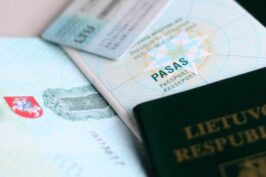- Home
- Lithuanian citizenship in the Klaipėda Region
Lithuanian citizenship in the Klaipėda Region


The Klaipėda Region was separated from Germany under Article 99 of the Treaty of Versailles of 28 June 1919. After the ratification of the Treaty of Versailles and its entry into force on 10 January 1920, execution of sovereign rights in the Klaipėda Region was transferred to the Triple Entente countries. On 16 February 1923, the Conference of Ambassadors recognized Lithuania’s sovereignty over the Klaipėda Region. In this way the Klaipėda Region became a part of the territory of Lithuania. Its legal status in the state of Lithuania has not been formally recorded yet, because under the Resolution of the Conference of Ambassadors of 16 February 1923 this should have been established in the Klaipėda Region Convention, which had to be prepared by the Conference of Ambassadors together with the representatives of Lithuania.
The Klaipėda Region Convention was signed in Paris on 08 May 1924. The Seimas of Lithuania ratified the Convention on 30 July 1924. Signatory States ratified it later. The Convention came into force on 25 August 1925, when ratification documents of England, Italy and Japan were deposited.
It has been established in Article 2 of the Convention that “the Klaipėda Region will form a unit of Lithuanian sovereignty, which will use the legislative, judicial, administrative and financial autonomy established by the Statute of the Supplement 1”.
Articles 8, 9 and 10 of the Klaipėda Region Convention determined which residents of the Klaipėda Region acquire Lithuanian citizenship and established the procedure of acquisition thereof.
According to part 1 of Article 8 of the Convention, Lithuanian citizenship is acquired ipso facto by those “former German citizens who, upon ratification of this Convention by Lithuania, would have been over 18 years of age and who would definitely have lived in the Klaipėda Region at least since 10 January 1920”.
Germany has committed to recognize the residents of the Klaipėda Region as citizens of that country, to which the Region will be joined. Therefore, the residents of the Klaipėda Region, upon acquisition of Lithuanian citizenship, shall lose German citizenship.
The Convention has also provided for the possibility of opting for Lithuanian citizenship. Opting for Lithuanian citizenship could be carried out by: a) each person who has born in the Klaipėda Region and lived there for more than ten years, who, upon ratification of this Convention by Lithuania, would have been over 18 years of age; b) each person who, upon ratification of this Convention by Lithuania, would have been over 18 years of age and who got a permanent residence permit from the Intereliant Administration, provided he has settled in the Klaipėda Region no later than on 01 January 1922 (part 2 of Article 8).
The opting for Lithuanian citizenship could be implemented within six months from the day Lithuania will ratify this Convention. When opting for Lithuanian citizenship, persons lost citizenship of other state.
Under Article 10 of the Convention, married women used to acquire the same citizenship as their husbands, and children under 18 years old used to acquire the same citizenship as of their parents.
The decisive period for a change of citizenship and reaching 18 years old is 30 July 1924. Until that date the residents of the Klaipėda Region (not including aliens) were considered to be German citizens.
“The Rules for issuing passports to citizens of the Klaipėda Region” were intended for implementation of the provisions of the Klaipėda Region Convention regarding citizenship and option agreement. Attention should be drawn to the fact that a name of the Rules is not legally correct, as it can be assumed that the Klaipėda Region citizenship and citizens have already been there. Neither the Klaipėda Region Convention, nor the option agreement provided for the citizenship of the Klaipėda Region, passports were also issued not to citizens of the Klaipėda Region, but to those who lived in the Klaipėda Region, who were immediately regarded as citizens of Lithuania under the Convention or were opted for Lithuanian citizenship. Such a provision was also consolidated in Article 1 of the aforementioned Rules, wherein its was established that “passports are issued only to citizens of Lithuania”.
According to Article 34 of the Klaipėda Region Statute, passports for the residents of the Klaipėda Region were issued by the Regional Directory, however, not on behalf of itselt, but in the name of the Republic of Lithuania and in accordance with the Rules laid down by the Government of Lithuania.
It has been established in the Rules that a person applying for the issue of a passport “must prove to the issuing institution that he has acquired Lithuanian citizenship”. The acquisition of citizenship must have been proven by documents. In individual cases, when a person was unable to submit documents specified in the Rules or circumstances or data indicated in those documents had to be supplemented or explained, “evidence of local residents characterized as reliable in a small rural distrist or town approved by their own signatures” could be accepted.
The Klaipėda Region Convention and the Option Agreement provided for which persons are considered to be Lithuanian citizens and which persons are entitled to opt for Lithuanian citizenship. Persons meeting the requirements established by the Convention had to be considered as Lithuanian citizens (they should have been regarded as Lithuanian citizens). Similarly, persons who opted for Lithuanian citizenship should have been considered Lithuanian citizens. The persons specified in the Convention and the Option Agreement could not be subject to the requirements established in the Provisional Law on Lithuanian Citizenship.
Nevertheless, this did not mean that the Law on Citizenship could not establish norms according to which other persons residing in the Klaipėda Region, who were not mentioned in the Convention and the Option Agreement, would be considered Lithuanian citizens or would acquire Lithuanian citizenship.
On 20 March 1939, Germany threatening by force presented its ultimatum to Lithuania to return the Klaipėda Region to Germany.
On 22 March 1939, the Treaty on the Transfer of Klaipėda Region between the Republic of Lithuania and the German State was signed, Article 1 whereof indicated that “From this day, the Klaipėda Region separated from Germany by the Treaty of Versailles is reunited with the German Reich.“
The Treaty between the Republic of Lithuania and the German Reich regarding citizenship of residents of Klaipėda was concluded on 08 July 1939. Under Article 1 hereof, “Lithuanian citizen who
- on 30 July 1924 or by opting Lithuanian citizenship has lost German citizenship, or
- is of German nationality and acquired Lithuanian citizenship by way of opting or birth, legitimacy or marriage, who derived their citizenship from indicated persons No. 1 and No. 2,
shall be considered as acquired German citizenship on 22 March 1939″.
These provisions were not applied to those persons of Lithuanian nationality who, before the signing of this Treaty, transferred their place of residence from the Klaipėda Region to Lithuania. The place of residence was “considered as transferred, if a person has left his permanent place of residence without any intention to return thereto” (part 2 of Article 1).
Therefore, under the Treaty, those residents of the Klaipėda Region, who until the moment of signing the Treaty, i.e. until 08 July 1939, left the Klaipėda Region without any intention to return thereto and settled in the Great Lithuania, were considered as not lost Lithuanian citizenship, provided Lithuanian state institutions will recognize that they are of Lithuanian nationality.
The Treaty provided for that persons of Lithuanian nationality, who have acquired German citizenship according to Article 1 of this Treaty, may until 31 December 1939 apply for the Consulate General of Lithuania in Klaipėda that they want to have Lithuanian citizenship. The Lithuanian citizenship was considered acquired after the issue of certificate that the application has been granted (Article 2).
Under the Treaty, a person could not have both Lithuanian and German citizenship at the same time: if in accordance with the provisions of the Treaty a person acquired citizenship of one state, he ipso facto lost the citizenship of another state (Article 3).
Attention should be drawn to the fact that when deciding whether a person is Lithuanian, not only his origin, but also national attitude was taken into account.
In order to prevent the use of Lithuanian passports for persons who were not considered to be citizens of Lithuania in accordance with the provisions of the Treaty, the Rules established that the internal or foreign passports or documents issued instead of them by the Klaipėda Regional Directory or its offices or the Klaipėda Regional Governorate, notwithstanding the expiry date specified therein, have been “withdrawn” since 01 January 1940.
MIGRATION LAW CENTER






























